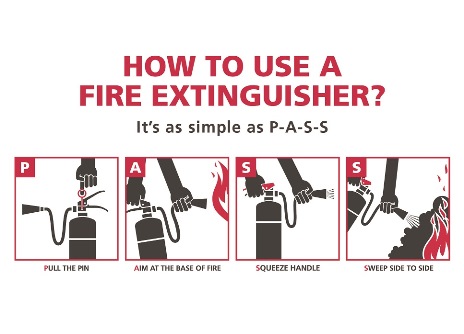How to Use a Fire Extinguisher
When using a fire extinguisher, stand away from the fire and follow the four-step PASS procedure recommended by the National Fire Protection Association:

- Pull the Pin: Hold the extinguisher with the nozzle pointing away from you and pull the pin.
- Aim Low: Aim the nozzle at the base of the fire.
- Squeeze the Lever: Squeeze the lever slowly and evenly to discharge the extinguishing agent. When the agent first hits the fire, it may briefly flare up. This is expected.
- Sweep the Nozzle: Sweep the nozzle from side to side, moving carefully toward the fire. Keep the extinguisher aimed at the base of the fire.
Home Protection with Fire Extinguishers
For your main home protection, install a 2-A:10-B-C rated extinguisher on every level of your home, no more than 40 feet apart. This could include locations such as living areas, garages, and workshops.
Kitchen Fire Safety
The kitchen is the most likely place for a fire. Protect your home with a UL-rated fire extinguisher, such as the Kidde Kitchen Fire Extinguisher.
Need Further Assistance?
If you have any questions or need further assistance, please don't hesitate to contact our customer care team.
They are available to help you with any concerns or inquiries you may have. Reach out to us for support, and we'll be happy to assist you!
Types of Fires
Fire types are divided into 5 classes based primarily on the fuel that is burning. Use this classification system to determine the most effective fire extinguisher based on your use case.
Types of Fire Extinguishers
There are many different types of fire extinguishers on the market, each with specialized capabilities. Each fire extinguisher is designated by: type, class & rating.
What are the fire extinguisher classes?
Learn about fire extinguisher classes: Class A (common combustibles), Class B (flammable liquids), Class C (electrical equipment), Class D (combustible metals), and Class K (cooking oils).
What are the fire extinguisher ratings?
Understand fire extinguisher ratings: Numbers 1-10 before A indicate the size of Class A fires it can handle; 10-80 before B for Class B fires; C signifies non-conductivity.
What Products Will Firex Alarms Interconnect With?
Learn more about the products that will interconnect with Firex alarms.